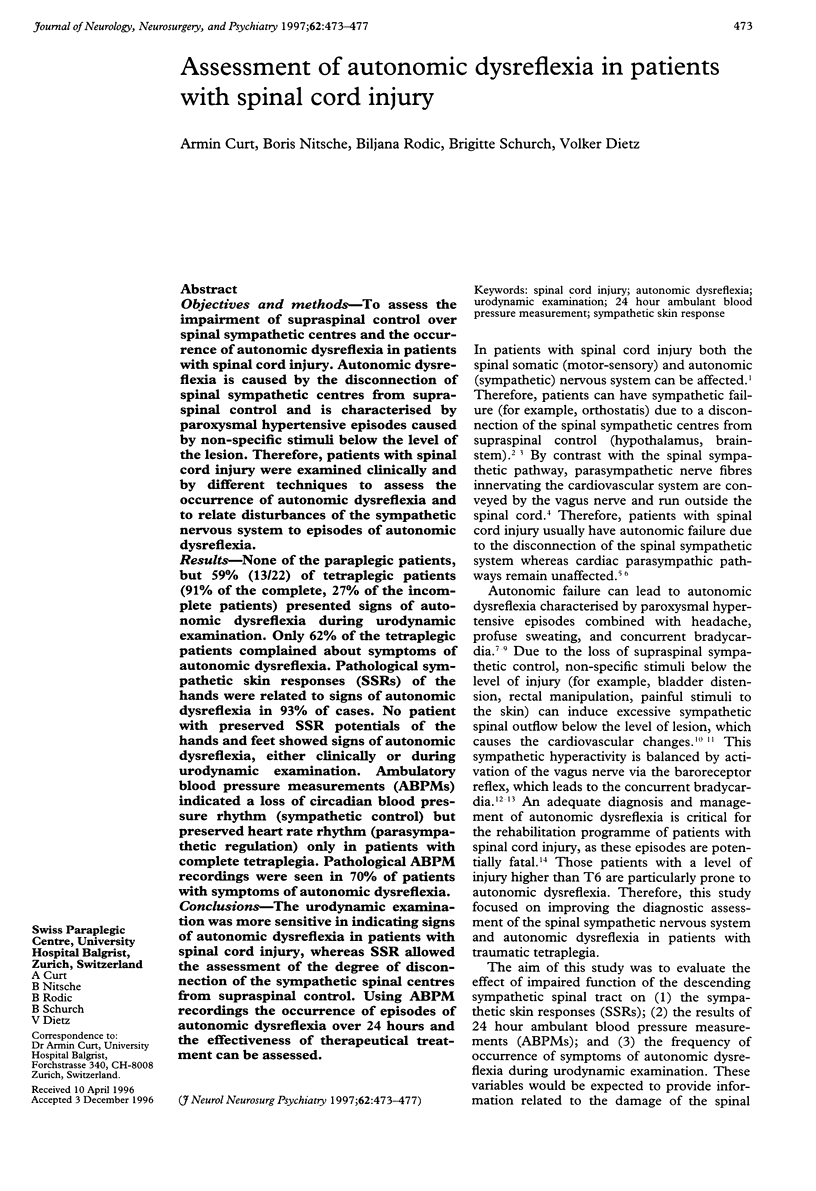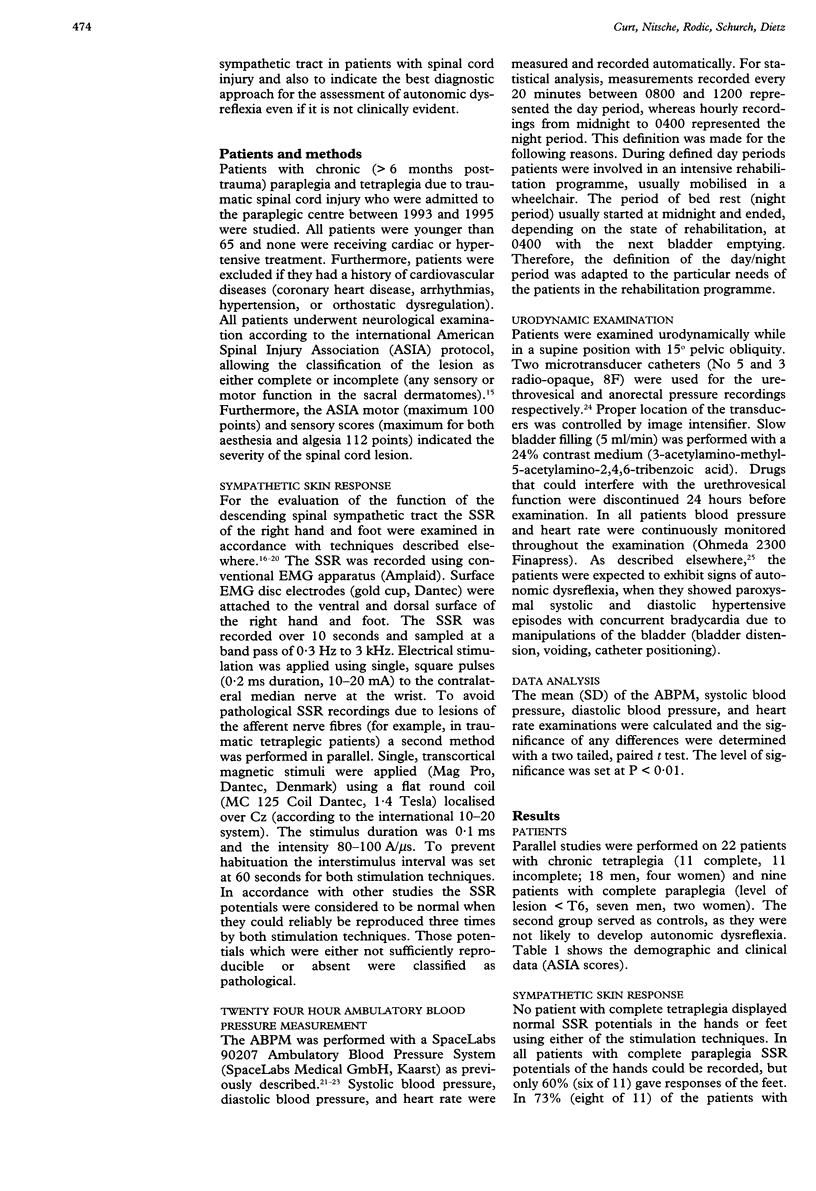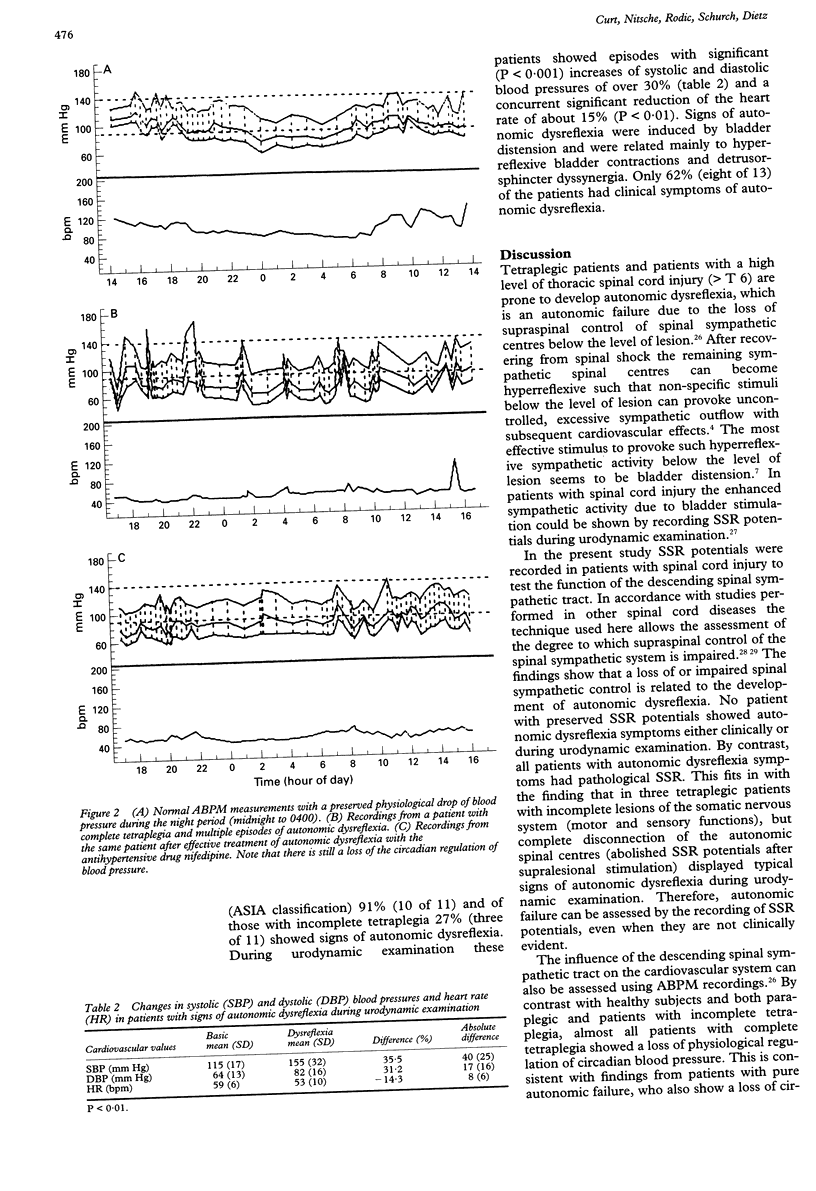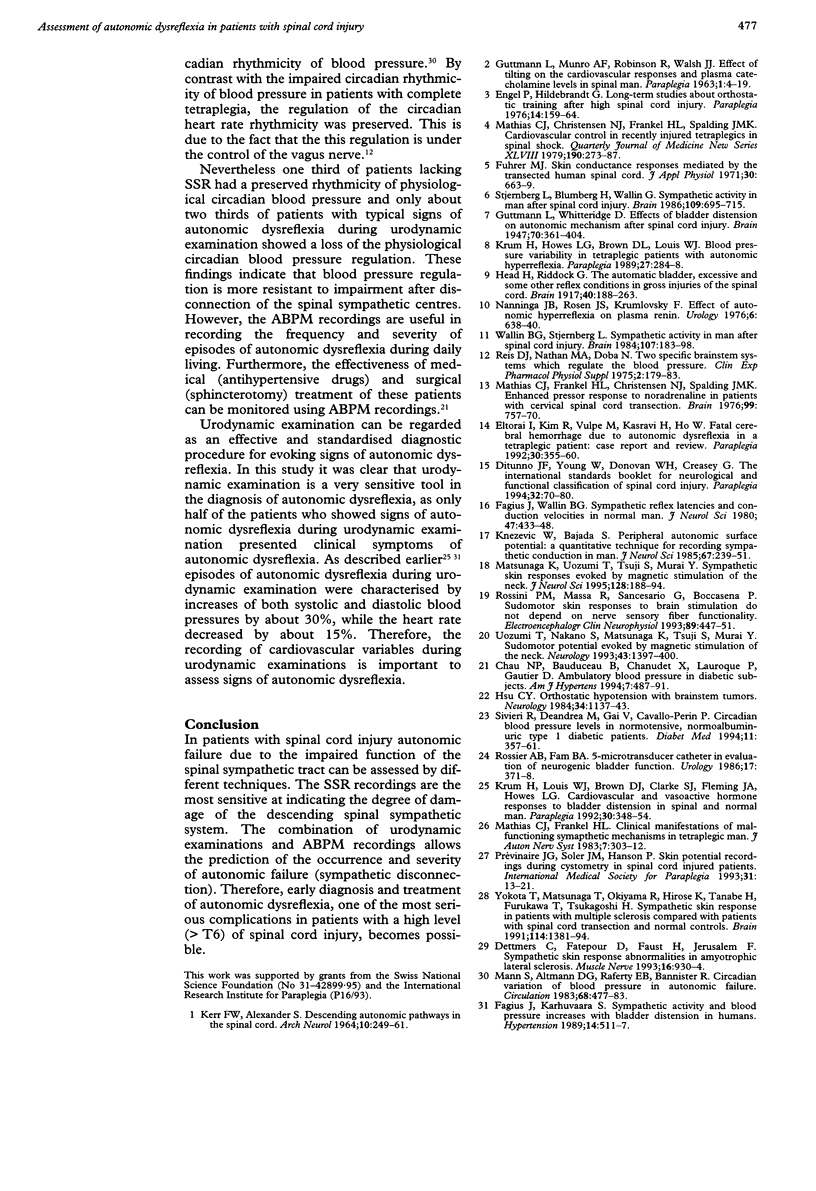Abstract
OBJECTIVES AND METHODS: To assess the impairment of supraspinal control over spinal sympathetic centres and the occurrence of autonomic dysreflexia in patients with spinal cord injury. Autonomic dysreflexia is caused by the disconnection of spinal sympathetic centres from supraspinal control and is characterised by paroxysmal hypertensive episodes caused by non-specific stimuli below the level of the lesion. Therefore, patients with spinal cord injury were examined clinically and by different techniques to assess the occurrence of autonomic dysreflexia and to relate disturbances of the sympathetic nervous system to episodes of autonomic dysreflexia. RESULTS: None of the paraplegic patients, but 59% (13/22) of tetraplegic patients (91% of the complete, 27% of the incomplete patients) presented signs of autonomic dysreflexia during urodynamic examination. Only 62% of the tetraplegic patients complained about symptoms of autonomic dysreflexia. Pathological sympathetic skin responses (SSRs) of the hands were related to signs of autonomic dysreflexia in 93% of cases. No patient with preserved SSR potentials of the hands and feet showed signs of autonomic dysreflexia, either clinically or during urodynamic examination. Ambulatory blood pressure measurements (ABPMs) indicated a loss of circadian blood pressure rhythm (sympathetic control) but preserved heart rate rhythm (parasympathetic regulation) only in patients with complete tetraplegia. Pathological ABPM recordings were seen in 70% of patients with symptoms of autonomic dysreflexia. CONCLUSIONS: The urodynamic examination was more sensitive in indicating signs of autonomic dysreflexia in patients with spinal cord injury, whereas SSR allowed the assessment of the degree of disconnection of the sympathetic spinal centres from supraspinal control. Using ABPM recordings the occurrence of episodes of autonomic dysreflexia over 24 hours and the effectiveness of therapeutical treatment can be assessed.
Full text
PDF




Selected References
These references are in PubMed. This may not be the complete list of references from this article.
- Chau N. P., Bauduceau B., Chanudet X., Larroque P., Gautier D. Ambulatory blood pressure in diabetic subjects. Am J Hypertens. 1994 Jun;7(6):487–491. [PubMed] [Google Scholar]
- Dettmers C., Fatepour D., Faust H., Jerusalem F. Sympathetic skin response abnormalities in amyotrophic lateral sclerosis. Muscle Nerve. 1993 Sep;16(9):930–934. doi: 10.1002/mus.880160907. [DOI] [PubMed] [Google Scholar]
- Ditunno J. F., Jr, Young W., Donovan W. H., Creasey G. The international standards booklet for neurological and functional classification of spinal cord injury. American Spinal Injury Association. Paraplegia. 1994 Feb;32(2):70–80. doi: 10.1038/sc.1994.13. [DOI] [PubMed] [Google Scholar]
- Eltorai I., Kim R., Vulpe M., Kasravi H., Ho W. Fatal cerebral hemorrhage due to autonomic dysreflexia in a tetraplegic patient: case report and review. Paraplegia. 1992 May;30(5):355–360. doi: 10.1038/sc.1992.82. [DOI] [PubMed] [Google Scholar]
- Engel P., Hildebrandt G. Long-term studies about orthostatic training after high spinal cord injury. Paraplegia. 1976 Aug;14(2):159–164. doi: 10.1038/sc.1976.27. [DOI] [PubMed] [Google Scholar]
- Fagius J., Karhuvaara S. Sympathetic activity and blood pressure increases with bladder distension in humans. Hypertension. 1989 Nov;14(5):511–517. doi: 10.1161/01.hyp.14.5.511. [DOI] [PubMed] [Google Scholar]
- Fagius J., Wallin B. G. Sympathetic reflex latencies and conduction velocities in normal man. J Neurol Sci. 1980 Sep;47(3):433–448. doi: 10.1016/0022-510x(80)90098-2. [DOI] [PubMed] [Google Scholar]
- Fuhrer M. J. Skin conductance responses mediated by the transected human spinal cord. J Appl Physiol. 1971 May;30(5):663–669. doi: 10.1152/jappl.1971.30.5.663. [DOI] [PubMed] [Google Scholar]
- GUTTMANN L., MUNRO A. F., ROBINSON R., WALSH J. J. EFFECT OF TILTING ON THE CARDIOVASCULAR RESPONSES AND PLASMA CATECHOLAMINE LEVELS IN SPINAL MAN. Paraplegia. 1963 May;1:4–18. doi: 10.1038/sc.1963.2. [DOI] [PubMed] [Google Scholar]
- Hsu C. Y., Hogan E. L., Wingfield W., Jr, Webb J. G., Perot P. L., Jr, Privitera P. J., Talbert O. R., Balentine J. D. Orthostatic hypotension with brainstem tumors. Neurology. 1984 Sep;34(9):1137–1143. doi: 10.1212/wnl.34.9.1137. [DOI] [PubMed] [Google Scholar]
- KERR F. W., ALEXANDER S. DESCENDING AUTONOMIC PATHWAYS IN THE SPINAL CORD. Arch Neurol. 1964 Mar;10:249–261. doi: 10.1001/archneur.1964.00460150019002. [DOI] [PubMed] [Google Scholar]
- Knezevic W., Bajada S. Peripheral autonomic surface potential. A quantitative technique for recording sympathetic conduction in man. J Neurol Sci. 1985 Feb;67(2):239–251. doi: 10.1016/0022-510x(85)90120-0. [DOI] [PubMed] [Google Scholar]
- Krum H., Howes L. G., Brown D. J., Louis W. J. Blood pressure variability in tetraplegic patients with autonomic hyperreflexia. Paraplegia. 1989 Aug;27(4):284–288. doi: 10.1038/sc.1989.42. [DOI] [PubMed] [Google Scholar]
- Krum H., Louis W. J., Brown D. J., Clarke S. J., Fleming J. A., Howes L. G. Cardiovascular and vasoactive hormone responses to bladder distension in spinal and normal man. Paraplegia. 1992 May;30(5):348–354. doi: 10.1038/sc.1992.81. [DOI] [PubMed] [Google Scholar]
- Mann S., Altman D. G., Raftery E. B., Bannister R. Circadian variation of blood pressure in autonomic failure. Circulation. 1983 Sep;68(3):477–483. doi: 10.1161/01.cir.68.3.477. [DOI] [PubMed] [Google Scholar]
- Mathias C. J., Christensen N. J., Frankel H. L., Spalding J. M. Cardiovascular control in recently injured tetraplegics in spinal shock. Q J Med. 1979 Apr;48(190):273–287. [PubMed] [Google Scholar]
- Mathias C. J., Frankel H. L., Christensen N. J., Spalding J. M. Enhanced pressor response to noradrenaline in patients with cervical spinal cord transection. Brain. 1976 Dec;99(4):757–770. doi: 10.1093/brain/99.4.757. [DOI] [PubMed] [Google Scholar]
- Matsunaga K., Uozumi T., Tsuji S., Murai Y. Sympathetic skin responses evoked by magnetic stimulation of the neck. J Neurol Sci. 1995 Feb;128(2):188–194. doi: 10.1016/0022-510x(94)00221-9. [DOI] [PubMed] [Google Scholar]
- Nanninga J. B., Rosen J. S., Krumlovsky F. Effect of autonomic hyperreflexia on plasma renin. Urology. 1976 Jun;7(6):638–640. doi: 10.1016/0090-4295(76)90093-5. [DOI] [PubMed] [Google Scholar]
- Prévinaire J. G., Soler J. M., Hanson P. Skin potential recordings during cystometry in spinal cord injured patients. Paraplegia. 1993 Jan;31(1):13–21. doi: 10.1038/sc.1993.3. [DOI] [PubMed] [Google Scholar]
- Reis D. J., Nathan M. A., Doba N. Two specific brainstem systems which regulate the blood pressure. Clin Exp Pharmacol Physiol. 1975;Suppl 2:179–183. [PubMed] [Google Scholar]
- Rossier A. B., Fam B. A. 5-microtransducer catheter in evaluation of neurogenic bladder function. Urology. 1986 Apr;27(4):371–378. doi: 10.1016/0090-4295(86)90320-1. [DOI] [PubMed] [Google Scholar]
- Rossini P. M., Massa R., Sancesario G., Boccasena P. Sudomotor skin responses to brain stimulation do not depend on nerve sensory fiber functionality. Electroencephalogr Clin Neurophysiol. 1993 Dec;89(6):447–451. doi: 10.1016/0168-5597(93)90120-e. [DOI] [PubMed] [Google Scholar]
- Sivieri R., Deandrea M., Gai V., Cavallo-Perin P. Circadian blood pressure levels in normotensive normoalbuminuric type 1 diabetic patients. Diabet Med. 1994 May;11(4):357–361. doi: 10.1111/j.1464-5491.1994.tb00286.x. [DOI] [PubMed] [Google Scholar]
- Stjernberg L., Blumberg H., Wallin B. G. Sympathetic activity in man after spinal cord injury. Outflow to muscle below the lesion. Brain. 1986 Aug;109(Pt 4):695–715. doi: 10.1093/brain/109.4.695. [DOI] [PubMed] [Google Scholar]
- Uozumi T., Nakano S., Matsunaga K., Tsuji S., Murai Y. Sudomotor potential evoked by magnetic stimulation of the neck. Neurology. 1993 Jul;43(7):1397–1400. doi: 10.1212/wnl.43.7.1397. [DOI] [PubMed] [Google Scholar]
- Wallin B. G., Stjernberg L. Sympathetic activity in man after spinal cord injury. Outflow to skin below the lesion. Brain. 1984 Mar;107(Pt 1):183–198. doi: 10.1093/brain/107.1.183. [DOI] [PubMed] [Google Scholar]
- Yokota T., Matsunaga T., Okiyama R., Hirose K., Tanabe H., Furukawa T., Tsukagoshi H. Sympathetic skin response in patients with multiple sclerosis compared with patients with spinal cord transection and normal controls. Brain. 1991 Jun;114(Pt 3):1381–1394. doi: 10.1093/brain/114.3.1381. [DOI] [PubMed] [Google Scholar]


